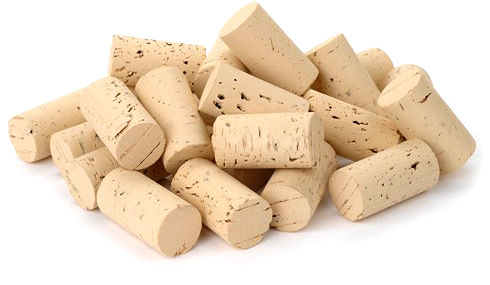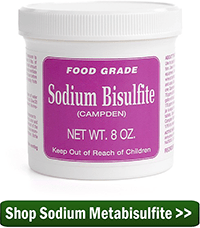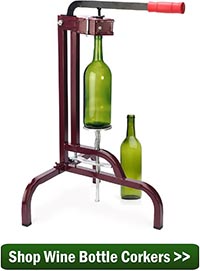 Correctly preparing corks for bottling wine is important. Not only should the wine corks be sanitary, but they should be softened just enough to allow your corker to put them in the wine bottle with ease.
Correctly preparing corks for bottling wine is important. Not only should the wine corks be sanitary, but they should be softened just enough to allow your corker to put them in the wine bottle with ease.
There are two basic ways to go about sterilizing and softening wine corks: This first involves submerging the corks in a solution of sodium metabisulfite and cold water. The second, involves steaming the corks in water.
Cold Soaking The Wine Corks:
Sodium metabisulfite and cold water makes a solution that will sanitize the corks. This solution can also soften the corks if they are allowed to soak long enough, usually over night, and it’s very simple to do.
 Mix 1/8 teaspoon of sodium metabisulfite to each pint of water and submerge the wine corks in the solution. Corks like to float. So I have found that using a container with a lid of some type will help you to get this accomplished. Use the lid to push down the corks into the solution.
Mix 1/8 teaspoon of sodium metabisulfite to each pint of water and submerge the wine corks in the solution. Corks like to float. So I have found that using a container with a lid of some type will help you to get this accomplished. Use the lid to push down the corks into the solution.
Let the wine corks soak long enough to make them slightly soft. You do not want the them to be spongy. You want them to be firm, but still give just a little. Remove the wine corks from the sanitizing solution and allow them to drain for a few minutes in a colander, strainer or something similar.
Steaming The Wine Corks:
Preparing corks for bottling by steaming them is much quicker than just soaking them, but it does take some care. It is very easy to over-steam the wine corks making them very spongy and hard to press into the wine bottle without mangling them.
Also, too much heat on the wine corks for too long will cause them to become brittle and crumble later on when they are pulled from the wine bottle. Excessive heat denatures the wine cork causing it to deteriorate while in the bottle.
Bring a pot of water to a boil then turn the burner off. Put the corks on the steaming water and place a lid over them. In just a matter of 2 or 3 minutes the corks should show some signs of softening. Once you feel the corks firmness start to give – just a little – rinse them in cold water to cool them down. They are then ready to be used.
Under no circumstances would I recommend preparing the wine corks by steaming them for longer than 5 minutes.
Which method you use for preparing corks for bottling is up to you. I feel the preferred method is to cold soak them, but if you forget to start that the day before bottling the wine, I can understand you wanting to steam the wine corks instead.
—–
Ed Kraus is a 3rd generation home brewer/winemaker and has been an owner of E. C. Kraus since 1999. He has been helping individuals make better wine and beer for over 25 years.

I mix my sanitizer then place it and my corks in a ziplock bag then squeeze out the air and seal. I leave this overnight, the corks stay moist and go in and out of the bottle with out aproblem.
I
Thanks for this valuable tip!
Hi, I soaked my corks with steriliser, and the water turned yellow. Is this normal or will my wine yet tainted?
Do you have an old coffee maker? I pour about two cups of solution into water storage of coffee maker and the corks [22] into the receiving pitcher. Turn on the maker and in less than ten minutes your corks are soft and sterilized.
Why do you always recommend sodium metabisulphite instead of potassium metabisulphite like everyone else. Why would I want to add sodium to my wine?
Richard, there has been a lot of discussion on this topic over the years. Some will indicate that it will leave a slight metallic taste or some other off-flavor in the wine. Others, will bring up the point of adding sodium – in general – to the wine… more sodium is not good. I have used sodium metabisulfite many, many times in my wine with no negative effects. Many other home winemakers have done the same, as well, with no problems, whatsoever. I have researched the amount of sodium it adds to the wine and after doing the math, it comes out to be about the same as the amount of sodium in two pickle slices per case of wine. Sodium metabisulfite is much less expensive than potassium metabisulfite. The reason I have put it in recipes and other places in the past is out of convenience. Home winemakers are much more likely to have sodium metabisulfite on hand than potassium metabisulfite. But having said all of this, it should be understood that either of these two can be used interchangeable in a recipe, sanitation or elsewhere, regardless of where your read it.
I have been making wine—mostly my own grape for over 10 years. This year my grape crop was not real good and I am having trouble getting it to ferment. I was just about ready too throw it out one morning and found a real good fermentation. My batch is only about 4 gallons. temptation is 85 +. I started with 110 and now it is down to 70 and stays there. I have added yeast and sugar twice. I suppose my problem is something real simple. anybody want too give me boost???? Thanks.
I used to soak the corks in sanitizer solution, but later learned that this can cause the corks to become brittle and fall apart when using some cork screws. This was especially true of the composite type of corks. As a result I now use a lite sanitizing, rather than a soaking and have had no problems. I also keep unused corks in an airtight container with a little bit of sulphite crystal’s in a cloth bag at the bottom.
I mix mine with a drop of sunflower oil, great no effort at all.
Because I have to store my bottles upright I have switched to synthetic corks. Do you have any advice on how to prepare these corks for bottling?
Bob, synthetic corks do not need to be soaked or steamed, etc. They need to be quickly sanitized with a sulfite solutions. Just put the corks in a seal-able container, like Tuperware bowl or similar and add water/sulfite solution to the bowl and seal up air-tight for a half-hour or so. The solution can be made by mixing 1/4 teaspoon of sodium metabisulfite with a quart of water. The synthetic corks do not need to be submerged. The gas from the solution will sanitize the corks as well. You do not need to rinse the corks off, you can take them right out of the solution and put them into the corker.
How do you feel about using a humidor or some other method of exposing the corks to metabisulfite and then eliminating any soaking? My floor corker will handle a cork that hasn’t been softened, but the sanitizing solution seems to end up gunking up the mechanism and can mean more clean-up.
Rod, using a humidor method, or the vapor off of a “sulfite” sanitizing solution would work fine.
I’m just getting started in making my own wine. I have noticed that the size of the corks can be different. What size do I need?
Justin, the opening of a standard, 750 ml wine bottle is 3/4 of an inch. If you have a wine bottle corker you will want to purchase either the size #8 or size #9 corks. Which size you get depends on the type of corker you have. The following article will discuss this topic in more detail.
What Size Corks Do I Need
http://www.eckraus.com/blog/what-size-corks-should-i-get-for-bottling-my-wine
I just let ’em sit submerged for 5-10 minutes in sanitizer. Goes in without a problem with a floor corker. Didn’t steam ’em or let ’em soak overnight. Guy a brewery store gave me these instructions.
This is also how I do it with a “hand corker.” I use one that has two levers you push down on to drive the cork through a smaller diameter throat and then into the bottle.
So is the soaking or steaming just for the ease of inserting the cork? I ask because although I have heard and read about it I have never done it. I just give a quick 15 min in sanitizer and cork. Have not had any problems yet. Been doing this about a year.
Jon, actually, steaming or soaking the corks does make them more pliable and easier to insert. However, both processes also sanitize the corks in the process.
Did you folks rinse the sanitizer off before inserting the cork? I’m new to all of this and am a little confused!
Vic, you do not need to rinse off the sulfite solution before using the corks.
I guess the wine gods are with me. I’ve been making my wine for 7 years now and have gone through 200+ corks. I have never sterilized the corks. Some of my bottles are over one year old. Neither have any (real) corks deteriorated nor have any bottles spoiled.
Same here, but for over ten years. I’ve used all type of corks and insert them dry right out of the bag with a floor corker. I’ve never had a bad bottle and I make about six kits per year.
I mix a standard solution of potassium metabisulfite/citric acid and put about 2-inches of the solution in a food grade 2-gal bucket. I place my corks in a plastic colander and then put the colander on top of the bucket (not touching the solution) with the bucket lid on top of the colander for about 30 minutes. This exposes the corks to the metabisulfite solution for sanitizing without wetting the corks.
I usually use the corks right out of the bags when new as they are supposedly packed sanitized with gas. Once opened i usually use the humidor method. I would be afraid to soak them over night in a sulfite solution in my thinking that what is absorbed in the cork may over sulfite the wine.
I also do not see the need to sanitize the corks before using them. Commercial wineries generally don’t. I think if you get corks from a reputable supplier you should not have a problem. If a cork is infected with TCA (cork taint) sanitizing will not eliminate the problem.
Hi folks,
I’m new to all of this and am going to be bottling wine for the first time tonight! I bought a bag of natural corks and I’m wondering if I should throw a little b-brite in the steam solution to make sure the corks are clean before inserting them in the bottles? If I do use b-brite, would I want to rinse the corks off before inserting them? Your advice is most welcome!!
Vic, we do not recommend using B-Brite to sanitize the corks. Other than steaming the corks, the only sanitizing solution we recommend using is a sulfite solution.
My beer is bottle-conditioned. I’m reluctant to put any sulphites in contact with it because that might stop the necessary yeast growth. One batch didn’t carbonate after a small amount of iodide sanitizer was left in a container. Do you believe any significant amount of sulphites are left on the corks?
Geoff, when sanitizing corks with sulfites for bottling wine, the residual sulfites will not harm the wine. With wine, you actually add sulfites directly to the wine to prevent spoilage. Wine bottles and corks are not designed to handle the pressure of bottle conditioning beer.
little cork is result of so much of hard working and precious steps.. glad to know this. thanks for sharing
Is a quick rinse with one step sufficient and ok to use on corks? I soaked #9 corks in pot met overnight and they were popping up out of the bottles. I read commercial wineries use corks with no soaking. So I did a quick dip in one step solution and let them sit to air dry and they won’t in and stayed in. Any problem with that?
Ed, this batch of wine will probably be okay. However, we do not know how the one step cleanser will affect the quality of the corks. Commercial wineries insert the corks dry because the use air pressure to insert them. Having the corks push back out is not uncommon. All you need to do is to keep pushing them back in until they stay in place.
Corks Pushing Back Out
https://blog.eckraus.com/my-wine-cork-stoppers-keep-pushing-back-out
Can I use Star SAN acid sanitizer to soak my corks in overnight? This is my first try at winemaking.
Patty, we would not recommend using Star San for your corks. It is best to either steam them or soak the in a sulfite solution.
I’m also pretty new to home brewing. Why is Star San not recommended? Thank you for your advice!
I just bottled for the first time (with wine bottles instead of beer) and of course just stuck corks into the corker and jammed them in the bottle. I sanitized the bottles of course, and the siphoning equipment. It wasn’t until after I was done that I thought maybe the corks shouldn’t look all smashed in the neck and maybe I should double check the process. I’ve got six bottles corked with dry unsanitized corks (standing upright). What should I do? Recork them? Nothing? Recork half and keep the other half as a control group?
Max, it is up to you if you want to re-cork the bottles. However, if it were me, I would re-seal the bottles.
Would 1 step no rinse cleanser work?
Ryan, we do not recommend using the one step no rinse cleanser because not all of the chemical will dissipate and can seep into the cork. You want to stick with the sulfites or steaming to prepare the corks.
So can I just throw the corks into a pot with water, boil for a couple minutes then let air dry? I dont like the idea of using anything at all.
This will work, but you want to put a lid on the pot. The corks will float on top so to treat all sides of the cork, you need to use a lid. Just a couple if minutes is fine. Then cool them down in cold water right away.
Do you need to dry the corks and inside of the necks after steaming, before you insert them?
Fritzi, you do not want to let the corks dry before inserting into the bottles. Part if the reason for steaming them prior to use is to make them more pliable and easier to insert.
Should you do this with synthetic corks?
Brenda, These wine bottle corks do not need to be softened. However, they do need to sanitized in a sulfite solution prior to bottling.